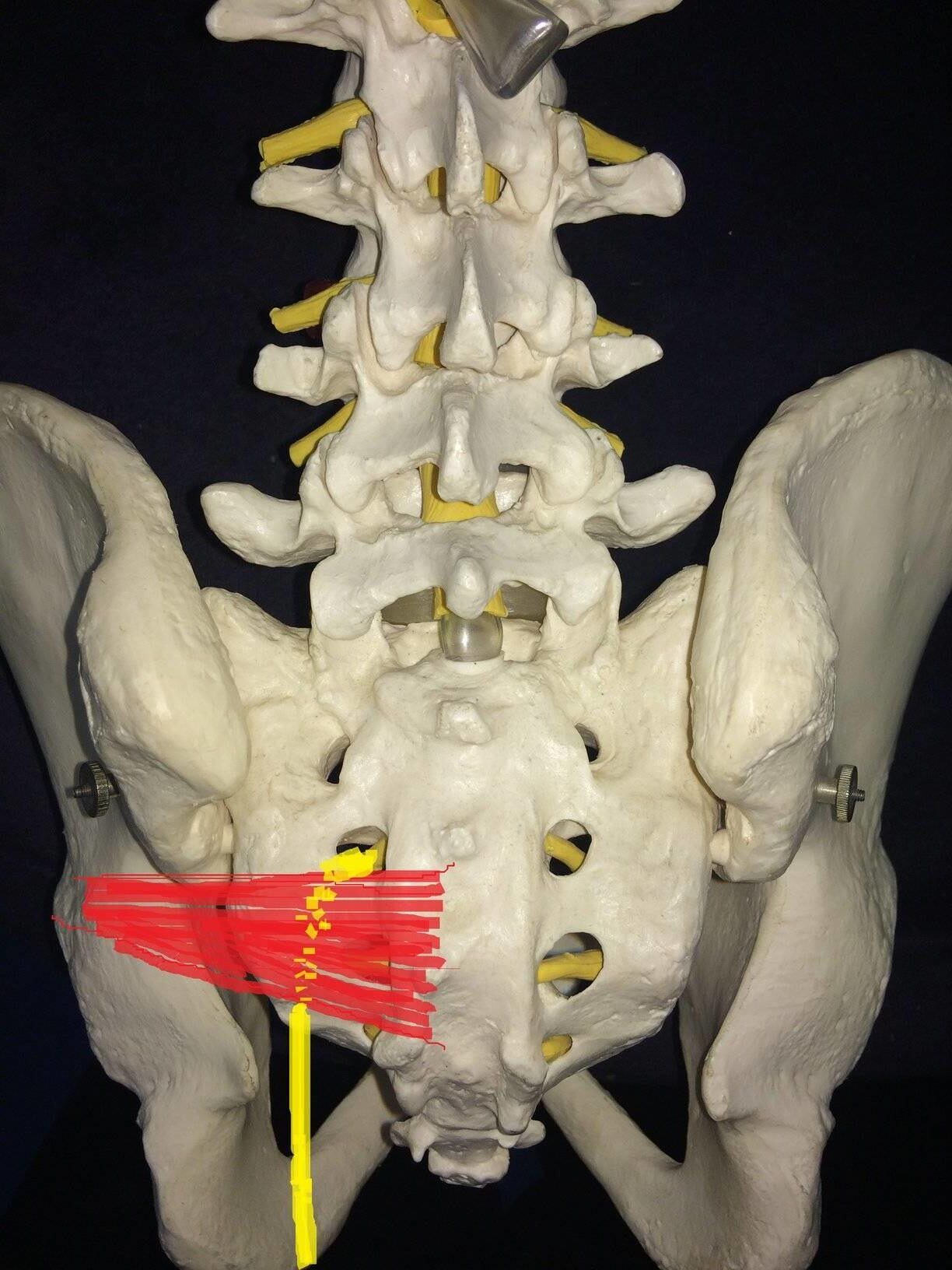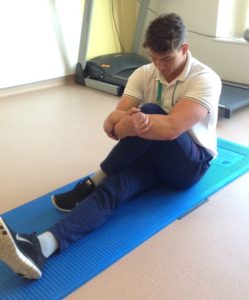Piriformis syndrome can be an extremely frustrating condition to diagnose and treat at home. Today, we’re going to talk about what causes piriformis syndrome and why piriformis syndrome can be such a nightmare!
I’m also going to demonstrate to you one key exercise that I used to help a client get out of pain in less than two weeks, even though she had been massaging her piriformis non-stop for over 3 months with NO improvement!
But first, let’s talk a little about the piriformis and the infamous piriformis syndrome…
The piriformis is a small muscle that lies deep within your buttock. It plays a critical role in stabilising your pelvis when walking, while also helping to externally rotate your hips and keep them level. If you didn’t have a piriformis, you would struggle to maintain a straight pelvis and your hips would drop to one side with each step.

The piriformis runs from your sacrum—where the base of your spine meets your pelvis—to the top of your thigh bone.
Before we dive in, please be aware that we are part of the Amazon Affiliate programme. This page may contain Amazon affiliate links, so if you choose to purchase a product for your sciatica that we recommend through a link on this page, we will receive a small commission at no extra cost to you. This helps us keep Overcome Sciatica alive! Thank you for your support. Please be assured that we only ever recommend products that we truly believe can help.
What is piriformis syndrome?
The sciatic nerve passes either right by or through the piriformis muscle (depending on your genetically-determined anatomy), and when the piriformis contracts or spasms, it can sometimes compress the nerve, resulting in pain that starts in your buttock and can run all the way down your leg.
We call this condition piriformis syndrome, and as anyone who has suffered from it can tell you, it is extremely painful!
Some people think of sciatica and piriformis syndrome as the same thing; technically, sciatica describes the SYMPTOM, while piriformis syndrome can be one of the CAUSES of the symptom.
You can hear me describe piriformis syndrome in more detail here:
Click Here to read about the other common causes of sciatica!
What causes piriformis syndrome?
Some of the common causes of piriformis syndrome include too much repetitive activity all in one go, or an occupation where you sit for most of the day.
Some of the repetitive actions that can cause piriformis syndrome include running and walking, which makes piriformis syndrome a very common running injury.
Other causes of piriformis syndrome include muscle imbalances (like weak gluteal muscles) and tightness in parts of the leg – including tightness in the opposite leg!
Sitting for long periods of the day can cause piriformis syndrome due to the weakening and shortening of the gluteal muscles. When this occurs, the piriformis is made to work extra hard to compensate for the weakness in other areas, which can eventually lead to muscle spasm and piriformis tightness.
Put simply, your piriformis could be severely fatigued from all that overtime work!
How to identify piriformis syndrome
Piriformis syndrome is usually identified by symptoms alone, so there often is no need for expensive scans in order to make a diagnosis.
Some common symptoms of piriformis syndrome include:
- Pain in the buttock on one side when sitting: This pain usually occurs right in the centre of the buttock, rather than under a buttock crease or over to one side.
- Pain that eases when walking or running: Usually, piriformis syndrome affects people more when sitting directly on the problem area. If getting up and walking around eases your pain, it could be piriformis syndrome.
- Pain running down your leg, but no back pain: Of course, it’s possible to have piriformis syndrome AND back pain – but most people whose leg pain is caused by their back will experience back pain and sciatica at the same time.
- Tenderness in the centre of your buttock: When you press on the middle of your buttock, it is likely to feel sore if you have piriformis syndrome.
How to treat piriformis syndrome
For most people, resting is usually not enough to conquer piriformis syndrome. This is especially true if the problem is caused by bad pelvic alignment.
But don’t worry – it is curable, and you almost certainly will not need surgery or injections to experience relief!
Most people with piriformis syndrome need a special exercise programme designed to correct the underlying issue, as well as step-by-step guidance on how to prevent it from coming back in the future.
One proven solution for piriformis syndrome is the method found in the programme that I recommend below:
Are You Looking for RAPID Relief from Sciatica?
My good friend, colleague and fellow international sciatica expert, Dean Volk, has a brand new sciatica relief video course available – and I’m delighted to be an official sponsor!
Check out Dean Volk’s “Kicking Sciatica OUT of the Butt!” Online Pain Relief Course Here!
I can proudly recommend Dean and his course for piriformis syndrome sufferers – because I’ve seen his incredible results first-hand. You can check out his course (and get lifetime access to the videos and bonus content) by clicking HERE.
When treating piriformis syndrome, the goal is to help the piriformis loosen and relax. If it’s pinching the sciatic nerve, loosening the muscle should significantly lessen the pain.
However, simply asking a partner to stick their elbow in your buttock to force the muscle to relax is a BAD IDEA!
“By pummeling the piriformis with hard massage, you can often actually make piriformis syndrome WORSE!”
– Will Harlow – Sciatica-Specialist Physiotherapist
A far better option for many people is to try stretching or massaging the OPPOSITE buttock. This sounds bizarre, but can genuinely help to fix imbalances and encourage relaxation in the problematic side!
This is the strategy I used to help my client to relieve her piriformis syndrome in 2 weeks!
I asked her to try the stretch below on the GOOD (non-painful) side:
Here are the instructions I gave her:
- Sit on the floor with your bad leg stretched out in front of you
- Cross the good leg over the bad leg
- Use your hands to pull the good knee towards your opposite shoulder
- You should feel a stretch in your good buttock. Hold for 30-seconds, 3-5 times per day.
The stretch in the video below gives a very similar effect if getting down to the floor is a struggle:
Check with your healthcare provider before starting any new exercise programme.
Other options for treating piriformis syndrome
Another great option for treating piriformis syndrome is experimenting with ice and heat. Some people prefer to use heat to relax the muscle, while others like the cold sensation and pain relief that ice brings.
There is no “right or wrong” with this approach – simply try using either method for 15 minutes and stick with the one that brought you the most relief.
It is a good idea to limit sitting for long periods while you recover from piriformis syndrome – try to set a phone alarm and get up and move every 30 minutes to avoid prolonged pressure on the aggravated muscle!
If you are a runner or athlete – be sure to warm up sufficiently before exercise, EVEN IF piriformis syndrome isn’t bothering you during your sport!
For more information on getting back to sport after sciatica, click HERE!
Summary
In summary, be sure to identify piriformis syndrome and act as soon as you can if you think you might be suffering from this condition. The earlier you act, the less likely you are to develop chronic pain as a result of this condition.
DON’T just sit on it! (Excuse the pun!)
As always, thanks for reading.
The information on Overcome Sciatica should never be used as a substitute for medical advice from a doctor. Never put into action any tips or techniques from Overcome Sciatica without checking with your doctor first. Please see full terms of use here.





